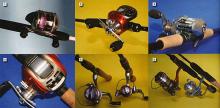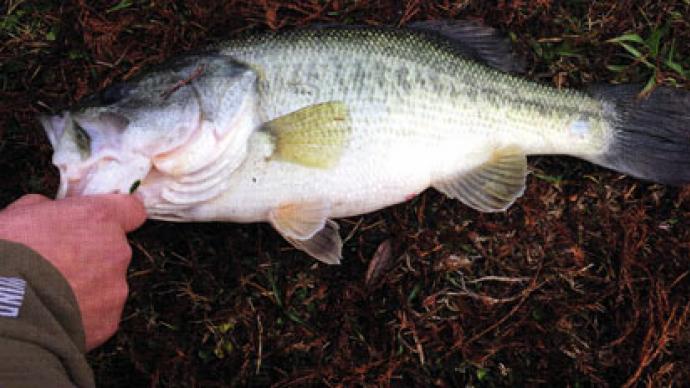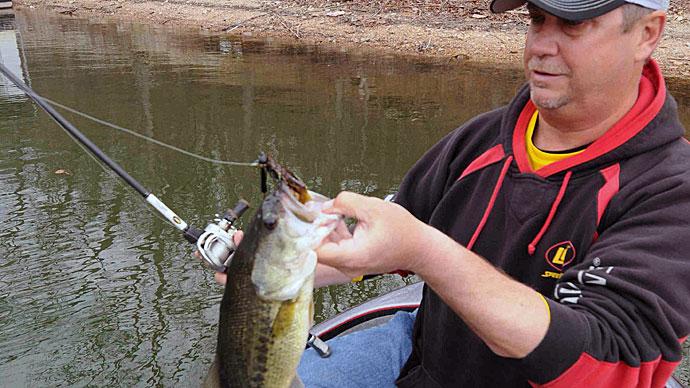A big fishing pole equals bigger fish. Wrong! When fishing small lakes and ponds, anglers using the correct gear will generally catch more and bigger fish than those who don't. Why? It comes down to casting and bait presentation to catch your pond's fish. Fish in pristine environments lack outside influences, and any unusual sounds, movements, or unnatural appearance will send them dodging undercover. While some ponds receive a great deal of fishing pressure, which "educates" fish, other ponds lack pressure, and those fish will be incredibly naive, making them easier to catch.
Choosing the right gear will help you catch the wiliest, wisest fish to the most naive fish in your pond.
Bass Fishing Gear
Depending on how the pond has been managed, bass will range in size. While some ponds have gigantic bass, most pond bass weigh between 3/4 to 1-1/4 pounds. When selecting the right gear, it's essential to know where to target fish live. Bass love cover, sometimes the thickest habitat in the pond. So it is not unusual that catching them might require a heavy rod and reel to fight bass buried deep in cover. On the other hand, skittish bass require an angler to have a long rod with plenty of backbone but a light action tip to make long casts with a light line.
Knowing your pond and its fish will help you choose the right fishing gear.
Baitcast Reels
Baitcast reels are available in various sizes and models...and price ranges. These reels can cost from $35 upward into hundreds. Unlike other fishing reels, baitcast reels require the most skill to use. An improper cast can cause a backlash or "bird's nest," as commonly referred to. The benefit of a baitcast reel is the absolute control and accuracy an angler has over their lure once they have mastered how to cast. There are several ways in which an angler can control a baitcast reel. The spool tension knob can be adjusted, so the lure falls slowly until it hits the water. Too much drag and the lure will not cast, and too little drag results in a bird's nest. Some baitcast reels have a casting control system built into the reel like a centrifugal or magnetic brake. When used with thumb pressure on the spool, anglers have complete control of where their lure will land. Baitcast reels are perfect for heavy 12 to 30-pound test fishing line, accurate casting, and power fishing.
Spinning Reels
While baitcast reels do the heavy work and require skill to cast successfully, spinning reels are built for finesse fishing and require only a little practice to master. Spinning reels have a fixed spool located in the front that allows the line to flow off during the cast. After the cast, the angler turns the reel handle to engage the bail that "feeds" line onto the spool while reeling. One option anglers will need to set is the anti-reverse setting. This switch allows the reel to lock the gear after the bail is engaged or enable it to spin free, allowing an angler to fight the fish with the rod and reel, not the drag.
Unlike baitcast reels, spinning reel handles can be switched and put on either the right or left-hand side, whichever the angler prefers. Spinning reels are built for a 4 to 12-pound test line and give the lure or bait a more natural appearance and cast light lures long distances without backlashing. Another advantage to spinning reels is an angler can gently cast live bait without losing their offering.
Ultra-light Reels
You have different choices when fishing for panfish, whether crappie or sunfish. Heavy fishing line gives the lure or live bait an unnatural look underwater, and fishing line-shy panfish will refuse to bite. They can see the line, which spooks them. Ultra-light reels are made for 2 to 6-pound test and can cast super light lures or live bait long distances. Catching smaller fish on light line can be highly challenging and fun. An added plus? You still have a chance at a big fish biting your lure. That's fun, too.
Spincast Reels
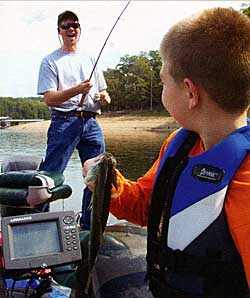
Spincast reels are the most trouble-free of all the reels and require little skill to cast. Although most are made for 4 to 12-pound tests, some can handle fishing lines up to 20 pounds and are great for catfishing or teaching beginners. Spincast reels can be used in almost any casting situation and are less expensive than other reels.
Gear Ratio and Drag
"Gear ratio" means the rate at which the reel's spool turns each time the reel handle turns one time, or 360-degrees. For example, for a reel with a gear ratio of 6.3:1, the reel spool turns 6.3 times for every one turn of the handle. A fast retrieve like a 7.1:1 gear ratio reel is perfect for fast-moving lures like lipless crankbaits or buzzbaits, while a slower 5.3:1 has more cranking power and is ideal for crankbaits.
Every reel has a drag system and needs to be set correctly to hook, play and land fish. A correctly set drag will smoothly pull the line off the reel as the fish resists, while a drag set too tightly will cause you to lose fish when the line or knot breaks. To set the drag, turn the control mechanism clockwise to increase the tension or counter-clockwise to loosen so the line can be pulled off smoothly under tension without breaking. A general rule of thumb for setting the drag is approximately 1/3 of the fishing line is rated.
Baitcast, Spinning Rods, and Ultra-light Rods
Baitcasting rods are designed to hold the reel on top of the rod blank and have guides on top. Spinning rods hold the reel below the rod blank, and guides are located on the underside. Baitcasting and spinning rod blanks are typically fiberglass, graphite, or a mixture of both materials with a PVC foam or cork handle. Handles come in various styles, including elongated two-handle, spilt-grip, pistol grip, etc. Ultra-light rods are generally 4 to 5Vi feet in length, much shorter than a normal baitcasting or spinning rod, which can typically be 7 feet. While shorter, ultra-light rods can cast lighter lures, on light line, long distances remarkably accurate. The limber, ultra-light rod makes catching panfish or small bass challenging and exciting.
Youth Combos and Fishing Kits
For younger kids, fishing is not all about catching fish but having fun while fishing...like skipping rocks, dancing around waiting for their bobber to go under, or holding their SpongeBob fishing rod combo while singing the SpongeBob Squarepants song. The yelling and screaming of fishing excitement start when their bobber goes under, and they reel in a fish. Then, the squeamish excitement stirs as the youngster tries to hold a lively sunfish while the proud parent takes a photo. Youth combos are made for smaller hands, shorter in length, and durable to take the abuse of younger anglers; some even float and come with fish-shaped casting plugs. These colorful combos commonly have cartoon caricature themes like SpongeBob Squarepants or Dora the Explorer.
It's easy to recognize the right gear for younger anglers; they are combos designed for smaller hands, shorter in length, may float if dropped in the pond, and kids enjoy carrying them around...even in the living room.
Fishing line
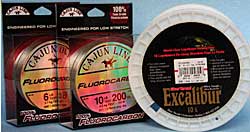
What fishing line you should use depends on the rod and reel combo. The three most popular fishing lines are monofilament, fluorocarbon, and braid. Each type of line has positive and negative qualities. The majority of anglers use monofilament. It is inexpensive, widely available, stretches under pressure, and comes in various colors and pound tests. Pound test refers to the breaking strength the line can hold at its weakest point. In other words, a 6-pound test line can hold six pounds of weight at its weakest spot. Youth combos or spin cast reels usually come pre-spooled with monofilament line.
Fluorocarbon fishing line is expensive compared to monofilament line. Fluorocarbon line has a slight stretch, and the line color is usually clear. Professional and serious anglers prefer fluorocarbon because it has the similar refractive index rating nearly identical to water, making it low visibility under the water's surface but visible at the surface. Anglers fishing ponds where fish are skittish or fishing line-shy may find that using this line will increase their catch ratio.
While monofilament and fluorocarbon lines are all-purpose type lines, anglers will find braid performs superior to them in certain pond situations. Braid fishing line is made by weaving or braiding fibers of a man-made material like Micro-Dyneema or Spectra into one strand of line. In ponds with thick, matted aquatic vegetation, braid works exceedingly well to hook and get fish out of heavy cover. Since braid has zero stretch, it is inappropriate for most fishing situations. Depending on the brand and design, each line manufacturer recommends which fishing line to choose for the reel you are fishing.
Right Gear
Selecting the right gear comes down to the angler knowing what species of fish they will catch and who will be using the equipment. A baitcast combo is appropriate for anglers who have mastered the skill of casting, but a grandchild fishing your pond will be able to cast the SpongeBob Squarepants combo, in addition to thinking their rod and reel is pretty cool. Using the right gear means catching more and, hopefully, bigger fish.
Reprinted with permission from Pond Boss Magazine


